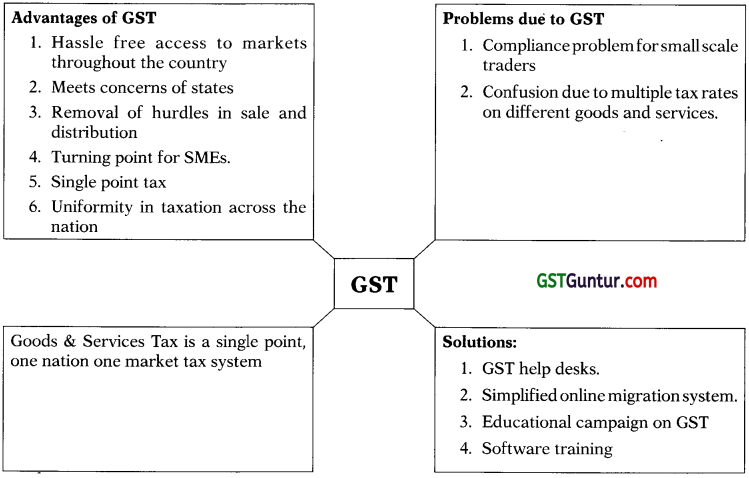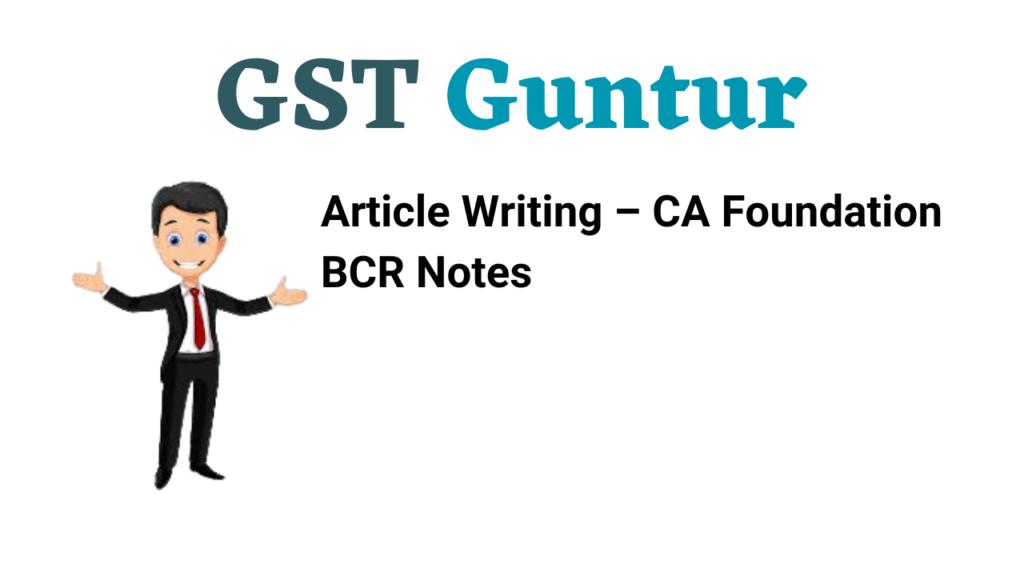Browsing through Article Writing – CA Foundation BCR Notes Pdf help students to revise the complete subject quickly.
Article Writing – BCR Notes CA Foundation
Meaning of An Article:
An article means a written text meant for publication in a newspaper, magazine or journal. It is meant for a wide audience. It may be written on a current issue (e.g. GST) or on a topic of general interest (e.g. organic food). It is written in a simple and interesting style so as to keep the readers engaged. In addition to facts, anecdotes and stories may be used in an article. Article writing is the process of writing a non-fiction text about a specific topic/issue.
An article, can provide:
- information
- suggestions and advice
- amusement to readers
- enable readers to think
- offer arguments for and against the issue.
![]()
Format of An Article:
The format generally used in an article is outlined below.
- Heading/Title : It should state the theme/central idea and should be eye-catching
- By line : Mention the writer’s name under the heading towards the right
- Introduction : Develop the context. Use quotations, anecdotes or startling facts to draw the attention of readers.
- Main Body : It may be divided in paragraphs. Each paragraph describes one aspect of the topic.
- Conclusion : A summary, or final opinion/recommendation/appeal is given in this last part of the article.
Step In Article Writing:
1. Decide the purpose of writing: First of all the aim of the article is decided. It may be to inform, describe, advise, etc.
2. Define the target audience: You must identify the intended readers of the article. The audience may be a specific group (students, businessman or sports persons) or general public.
The purpose and the target audience are the bases for deciding the style and language of the article. For example, if the topic of the article is “Careers in Accountancy” then the target audience will be students of Accountancy. The article should be informative containing details of various careers available to the students. The language should be easy and straight forward. Formal tone should be used.
3. Collect necessary information : Once the purpose and the target audience are decided, the next step is collecting the information available on the topic. Books, journals, Internet and other sources may be used for this purpose. The information collected must be authentic, accurate and reliable.
4. Organize the information : The information must be organized in a logical and sequential manner. Flow charts and mind maps may be used to organize the content.
For example:

5. Write the article : After the information is properly organized, you can write the article. First of all write a title/heading to catch the attention of readers. Then write an opening sentence that creates readers’ interest in the topic. Give solid arguments to support your idea. The language and vocabulary used in the article must be appropriate. Humours and rhetorics can be used to make the article interesting and to sustain the interest of readers. At the end, you can conclude with the strongest point.
![]()
Essential Elements of Article Writing:
- Decide the purpose of writing the article – to describe, inform, advice, compare, entertain, etc.
- Choose a relevant topic.
- Understand the target group of readers.
- Select a short and eye-catching title.
- Open with a striking sentence to obtain readers’ interest in the topic.
- Choose your idea before starting to write.
- Avoid irrelevant information and unnecessary repetition
- Divide the article into suitable paragraphs
- Use appropriate tense and voice
- At the end give a logical conclusion.
Sample Articles:
Crowd Funding – In recent decades several innovations have taken place in the financial sector. Crowd funding is one of them. Crowd funding is the practice of funding a project by raising money from a large number of people. It is a method of raising capital collectively from friends, family, customers and individual investors through an e-platform for a specific venture. It provides one alternative channel of funding for startups. Crowd funding is the opposite of the traditional approach to business finance.
A business plan is first prepared and the idea then put before banks and financial institutions, which limits funding options to few key players. Failure to approach the right investor at the right time could lead to an unsuccessful attempt to raise money. On the other hand, crowd funding provides entrepreneurs a single platform to build, show case and sell the ideas. Funds can be raised in a specified time frame (e.g. 90 days). Fees and rules differ across different platforms. In most common and popular forms of crowd funding, investors are neither promised repayment nor any stake in venture if it is successful. Crowdfunding typically tries to resolve the issues of marketing and finance together.
The crowdfunding model has three main players : the project initiator (proposer of idea or project to be funded), individuals or groups who support the idea, and the platform that brings the parties together to launch the idea.
Crowdfunding has been used to fund a wide range of ventures – both for profit and not-for-profit- projects. Enterprises that lack capital raise funds from personal savings or close from friends and relatives. Crowdfunding helps reduce the chance of promising projects not getting initiated due to shortage of funds. It thus prevents the loss of jobs and potential innovations.
[Source : Indian Management, September 2017, pp. 81-82]
Sustainable Development:
Development, to be sustainable, must include not merely material growth, but also, and perhaps more importantly, the blossoming of cultural, intellectual, spiritual and other non-material aspects of human existence. Unfortunately, the Western notion of development has side lined all these aspects and brought materialism to the centre stage.
Even all intellectual and cultural growth seems to be geared towards the aim of making money and accumulating goods. This has led to the fast depletion of renewable resources and outflow of industrial affluents and wastes adversely affecting the environment. Consequently, it is now recognised that development to be real for all must be ‘sustainable development’.
Sustainable development seems to have different meaning for different people. The World Commission on Environment and Development defines it as “development that meets the needs of the present generation without compromising the ability of future generations to meet their own needs”. As such sustainable development is the process in which the exploitation of resources, the direction of investments, the orientation of technological development, and the institutional changes are all made consistent with the future as well as present needs. Central to the concept of sustainability is the carrying capacity approach which can be defined as maximum rate of resource consumption and waste disposal that can be sustained indefinitely in a given region without progressively impairing diversity and ecological integrity.
Meeting the needs of the poor in this generation is an essential aspect of sustainably meeting the needs of the subsequent generations. Thus, sustainable development is a process in which economic, fiscal, trade, energy, agricultural and industrial policies are designed to bring about a development that improves health care, education, and social well-being and reduces absolute poverty through lasting and secure livelihood that minimises resource depletion, environmental degradation, cultural disruption and social instability.
Sustainable development demands a reduction in fertility rates by increasing literacy and education of women and girls. It demands drastic reduction in the inefficiency and wastage in our schooling system expressed in the massive drop-out rates and educated unemployment.
![]()
It demands such a policy which is based on a dispersed pattern of human settlements, low-cost water supply and housing and the recycling of wastes. It demands optimal use of the medical infrastructure that we have built and will further build particularly in rural areas. Above all, it demands a positive as against the present normative, approach to the major socioeconomic problems of unemployment, poverty and inequality, which can never be addressed effectively without the involvement of people. After all, development is for people and as such an essential element in the development process is people’s participation. It may be emphasised that even with the best of intentions planning for sustainable development can never be effective without participation of people.
